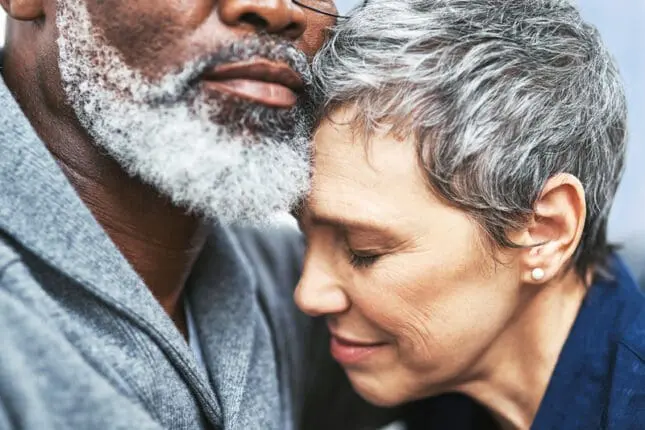“I was griping to Laura just the other day about how we used to get more years out of our appliances,” Stan said. “Now you pay all this money, and they die faster. Think it’s the same for marriage? After 40 years, maybe we need a new warranty!” He looked first to his wife, Laura, then to me, with a sheepish grin.
Laura shifted her body toward me and returned his gaze with a stern eyeroll. “Ever the jokester,” she replied.
I’d last seen Stan and Laura eight years before and was struck by how instantaneously we slipped into a timeworn track. As they chronicled their current challenges—a relapse in their daughter’s addiction, the loss of their painstakingly crafted postretirement life because of financial stresses, and the challenge of having to care for grandchildren more than they’d expected—I sensed a familiar disconnect and pain.
“Per usual, Stan left out the real reason we decided to come in,” Laura finally announced. “I gave him an ultimatum to do something about his health or I’m out the door. He thinks he’s invincible and can ignore the doctor’s advice. I can’t be a party to it! He has type 1 diabetes, for God’s sake! It’s affecting his heart, his blood pressure, even his vision.” Laura—lithe and energetic at 73, and partial to yoga pants, oversized blouses, and bright jewelry—tossed out this comment with a fierce, no-nonsense edge to her voice.
Stan, 76, who’d gained more than 25 pounds in recent years, looked away. His hair had gone completely white, and his gait had slowed, but he continued to be a meticulous, well-styled dresser. There was a new, desperate quality to their interaction, and I imagined what it had taken for Laura, deeply committed to their marriage, to issue an ultimatum.
“Last time we saw you, we talked about thinking like a team and remembering the love between us,” Laura said, her voice trembling a bit. “I even got out some of the ‘we stories’ we wrote with you back then to bring us together.”
I recalled how they’d described their love as forged in the challenges of racial discrimination and family opposition, and how they’d come to feel stronger together than apart. They saw themselves as risk-taking pioneers of the early ’70s. Stan had said, “We had guts as a Black man and a white woman, a practicing Catholic and a Jew, pushing at societal boundaries.” Laura was frightened by what she saw as Stan’s new passivity. He was less enamored of their former identity as pioneers and often said, “I just want our life to be low-key and peaceful.”
Couples like Laura and Stan, who reach a high-water mark of longevity, often feel a sense of surprise and pride for still being together, along with a sense of bewilderment about how they could still be having issues when they may have so little time left.
Laura sighed. “I tell him I’m scared for his health, scared for us. But it just falls flat, and nothing changes. We’re stuck.”
Stan responded with a head nod.
A Longer Story than Ever Before
Gerontologist Louise Aronson writes in Elderhood that a person’s passage into older adulthood is “less a switch thrown than a series of ill-defined thresholds crossed.” From around 70 onward, chronological age becomes at once defining and immaterial. Since our culture has such a wildly ambivalent relationship to aging, vacillating between stories of decline and reinvention, a couple’s experience of aging often reflects those conflicts, making it essential to examine the stories we tell about this time.
For example, Stan described a recent conversation with a neighbor his age who’d taken up martial arts and race walking. “I don’t know what he’s trying to prove. We’re supposed to be slowing down now, not revving up, right? Laura thinks the guy’s terrific! I think he’s crazy.”
Used to being more in sync, they were now experiencing great differences in their thresholds for change and growth. While these differences occur across the lifespan, they may cause more distress in later life, perhaps because of physical changes and the longing for greater unity and peace. Stan said, “We just can’t seem to get on the same page. She talks about selling the family home, traveling, maybe even moving away from the grandkids, and I don’t want to do any of that. We also argue more than ever about my health.”
Unspoken by both Laura and Stan was the specter of widowhood, which triggered fears of being alone. I knew that buried under their disappointment and resentment, they wanted to make as much sense of their relationship as they could, so they’d be freer to live more fully in the moment. The lesson of the elder story is that life is extraordinarily valuable precisely because it is so transitory.
Identifying a Stuck Story
In their stuck storyline, Laura tended to present herself as the one in the know, always ready to enlighten Stan with suggestions for improvement. Stan long resented being her “improvement project” but often went along to “keep her appeased.” Neither felt good about this, so building a new story began with examining the individual stories they told themselves about each other, and helping them remember that stories are interpretations, always open to editing.
I asked the couple to begin our sessions by sitting in silence and making eye contact while focusing on their internal states. They both observed how frequently their minds tended to drift to some version of their stuck story and then got triggered and anxious. I explained that they couldn’t connect when feeling so threatened and coached them to notice the differences they felt in their body between the unsafe, distressed state and the more relaxed, open one. I reminded them to try and communicate safety and friendliness through kind eyes, a calm tone, and an inviting posture.
Stan remarked, “When I feel like Laura’s unhappy with me and about to get on my back about something, I get this pain right between my eyes that spreads to the back of my head. Now I know it’s a sign that I’m feeling threatened, and I need to breathe more before I can pay attention.”
Laura responded, “When he relaxes, I can relax, and my gut automatically unclenches.”
During our early work to identify their stuck story and help them crystallize the challenge they were confronting, they came up with a metaphor that became the narrative theme we used as a touchstone to focus our discussions. Describing a recurring argument, Stan complained, “We’re like mismatched fighters in a ring,” with Laura landing the jabs while he ducked. They recognized that earlier in their relationship, it was Stan who’d made the jabs that Laura had tried to outmaneuver. They agreed that the boxing ring felt confining and kept them both in rigid positions.
Over time, Laura began to acknowledge that her controlling anger masked fears about her own worsening arthritis, triggered whenever Stan violated his diet or forgot to monitor his insulin. Stan acknowledged that Laura’s control reignited early feelings of inadequacy and helplessness as a Black man navigating a racist society. By examining their stuck stories, Laura learned that she couldn’t manage change through rigid control. Stan learned that he couldn’t find peace through avoidance.
Voicing a mutual desire to “get out of the ring,” they agreed they were trying to manage new vulnerabilities with their old roles. They’d never talked about becoming each other’s caretakers—what that might look like and how they felt about it. We explored various scenarios of a likely future in which they’d need to be caretakers for one another at different times, and they were most frightened about the possibility of being simultaneous caretakers.
Stan realized that speaking up more and informing Laura about what he was doing to manage his health actually soothed them both. Laura realized that her efforts to micromanage Stan were backfiring and that she wanted to treat him more mindfully and respectfully.
With accumulated compassion, they began to ask the right questions: What can we do to make this better? How can we be helpful to each other? How can each of us give to the other more of what they most want?
They agreed to visit Stan’s doctor together and to see a diabetic nutritionist, with Stan initiating Laura’s type and frequency of involvement. Laura shared more with Stan about her exercise plans to manage her arthritic knees. They identified a metaphor for their new story as “loving sparring partners,” who invited one another into the ring to “play, not fight.” Gradually, they began to reframe their issues as manifestations of deep caring instead of distancing control.
Exemplifying their shifting perspective, Laura said in one session, “Stan is a terrible dancer. Over the years, I’ve tried everything to change it: shaming him, dragging him to dance classes, refusing to dance with him.” She winces at the memory. “But my story about him has changed. Now I’m just grateful that he still wants to dance with me, that he tries, and I don’t care how we look when we get on the dance floor at weddings. I realize he asks me to dance because he knows how much it means to me.”
Stan replied, “I do it because I know you want to be asked.” He paused for a moment, thinking. “And I know that your questions about my insulin are because you want to keep me around, and I’m grateful to you.”
Revising a Stuck Story
To replace their stuck story with one of success and healing, Laura and Stan needed to craft a new vision of what they wanted their relationship to look and feel like. They spent several weeks reflecting, recalling, evaluating, and revising the dreams they’d had at various times in their relationship.
They decided to channel their crusading spirit into three priorities. First was being “health helpmates,” championing one another’s efforts to monitor their health. Second, they resolved to be good parents/grandparents, which involved drawing up a plan for their daughter and grandkids that clarified the limits of their financial support. And third, they decided to be more active community members, which meant helping in the neighborhood garden and delivering food to donation banks.
The new vision evolved into their healing story:
In our early years, we were risk-takers who pushed boundaries. Eventually, we applied that spirit to times when we faced tough obstacles, like our daughter’s addiction. Someone else might’ve given up on their partnership through that nightmare, but we stuck it out and respect what we each brought to the ring. At the end of the day, we want to be there for each other. We want to make caring for each other our first priority. We want to teach our children and grandchildren the values of compassion and generosity—and respecting one another’s limits.
After writing out their story, they chose a special frame to put it in and displayed it in on their bedroom dresser, where they’d see it easily.
Older age is the season when couples can reap the benefits of earlier adjustments and transformations and relish the wisdom of passing time. Laura described this poignantly during our last session: “We’re the only ones who can see in each other all that has been—the young lover, the new parent, the aging grandparent.”
They reminded me that long-term love is a history of different loves for one’s partner at different periods of life. This multiplicity is what gave Stan and Laura’s relationship more dimension and depth, allowing each partner to be the one who keeps track, remembers, and renews.
PHOTO © I STOCK/PEOPLEIMAGES
Karen Skerrett
Karen Skerrett, PhD, is a clinical psychologist and registered nurse with over 40 years of experience as a clinician, academic, and author who specializes in strength-based approaches to healing and change across the lifecycle. Her latest book is Growing Married: Creating Stories for a Lifetime of Love. Learn more at karenskerrettphd.com.













